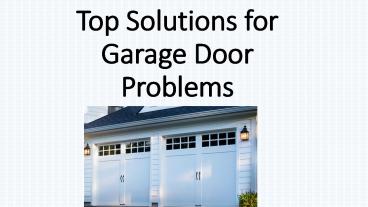Top solutions for garage door problems PowerPoint PPT Presentation
Title: Top solutions for garage door problems
1
Top Solutions for Garage Door Problems
2
Is the Cord Plugged In?
- When troubleshooting a problem, it's best to
begin in obvious territory. You likely checked
whether everything's plugged in, but it still
doesnt hurt to ask. Some people unplug the
machine-head cord to save power, so check that
it's secured. The same goes for everything else
as well. Anything which requires power or
involves a wire should appear fully functional.
If your garage suddenly started acting up, it
might be something as simple as a loose plug.
3
Check Your Batteries
- When diagnosing a malfunctioning garage door, the
problem often stares you right in the face. An
obvious reason why a stubborn door won't open
concerns the batteries. Yes, it doesn't take a
garage door expert to know that batteries die,
and its easy to forget to check them.
4
- Open your garage door opener and change the
batteries. If the garage door still won't open,
maybe there's another source of dead batteries
involved. Sometimes wall transmitters run on
batteries, so investigate every possible source
of a pesky dead battery. Once discovered, switch
those batteries out and see what happens. If the
door continues to ignore you, there's a number of
other possible issues at play.
5
Examine Your Electronic Keypad
- Unusual trends in door activity often derive from
electronic keypad issues. Where is your keypad
now? Is anything coming into contact with its
buttons or surface? Occasionally, keys become
fixed in unnatural positions due to moisture or
unwanted contact with adhesives.
6
- Essentially, you want to confirm that the keypad
remains in optimal condition. If the keypad shows
any signs of wear or damage on the outside,
perhaps its inner hardware is even worse. Give
the keypad a thorough inspection and make sure
it's functioning perfectly before removing it
from the list of suspects. During your
investigation, you want to rule out every
possible cause for an errant door. - If your keypad doesn't appear fully functional,
consult a professional like us to confirm the
keypad as the source of the issue. Replacing
keypads isn't an uncommon or extravagant
solution.
7
Keep Your Electric Eye Open
- Your garage door relies on a pair of
photosensitive eyes to maintain operational
safety. These sensors sit about a foot above the
ground on both ends of the garage door opening.
They shoot out a beam which crosses the path of
the door opening. If the path of light becomes
obstructed, then the doors will fail to open or
they will not close all the way.
8
- Of course, this feature is an important safety
component. Without the sensors, your door might
close on a person or object, causing injury or
damage as well as possibly damaging the garage
door.
9
Maintain Sensor Functionality
- What if your sensors' eyes align, but the door
still won't close or a sensor's light keeps
blinking? In this case, your sensors may suffer
from faulty wiring. The wires which connect the
sensor to their power source often deteriorate.
They look like two small speaker wires leading
from the sensor's back. If they show corrosion or
fail to make firm contact with the sensor, then
you'll need to repair or replace the sensor or
call Garage door repair man.
10
Rule out Rusty Staples
- This easy check eliminates the possibility that a
rusty staple is impairing the sensor's
connection. Sometimes during installation, an
errant staple may puncture the sensor's wire.
Although it didn't impede the connection before,
suddenly it decides to wreak havoc.
11
- Through the vibrations and weathering of the
staple's closeness to the garage door, it will
one day sever the connection. Just examine the
sensor's wiring as it leads around the doorframe,
checking for malicious staples. If found,
readjust the position of the wire, which will
hopefully restore the connection. If the wiring
damage exceeds this solution, call a
professional.you should remove these rusty
staples and consult Garage door repair man.
12
Self-Opening Garage Doors
- Is your garage door seemingly possessed? Does it
open and close whenever it pleases? Before you
call a garage door exorcist, check out your
transmitter. Interference may cause your
transmitter to activate your door at unexpected
times.
13
- The most common type of transmitter interference
concerns the location of the transmitter itself.
Is anything coming into contact with the
transmitter? If an object accidentally sets off
the transmitter, it will appear as though your
door magically opens on its own accord. Do a
little sleuthing to rule out any possible
physical interference involving all your
transmitters.
14
Door Refuses to Open
- If your door won't go up, there are several
factors to consider. Before you curse your door's
laziness and lack of vertical ambition, examine
the torsion springs. Most garage doors operate
using a double torsion spring system. Look up,
and you'll see these metal coils on the shaft
along the opening of your door.
15
- These springs convert their twisting force, known
as torque, into the upward momentum which raises
the door. The torque travels along the shaft and
into the cable drums which carry the weight of
the door up. These cable drums convert their
twisting into the upward movement of the door.
This happens through a transfer of tension which
raises the door using upward volition.i it does
not work properly you should show a Garage door
repair man.
16
Garage door repair
- ADVANCED EXPRESS TECHNICAL SERVICE LLC
- P.O.BOX 127804, DUBAI, U.A.E
- Telephone971-4 2554590
- Telephone971-50-1725959
- FAX971-4 2554890
- E-mail info_at_aetsllc.com
- E-mail aets_uae_at_ymail.com
- websitewww.aetsllc.com

